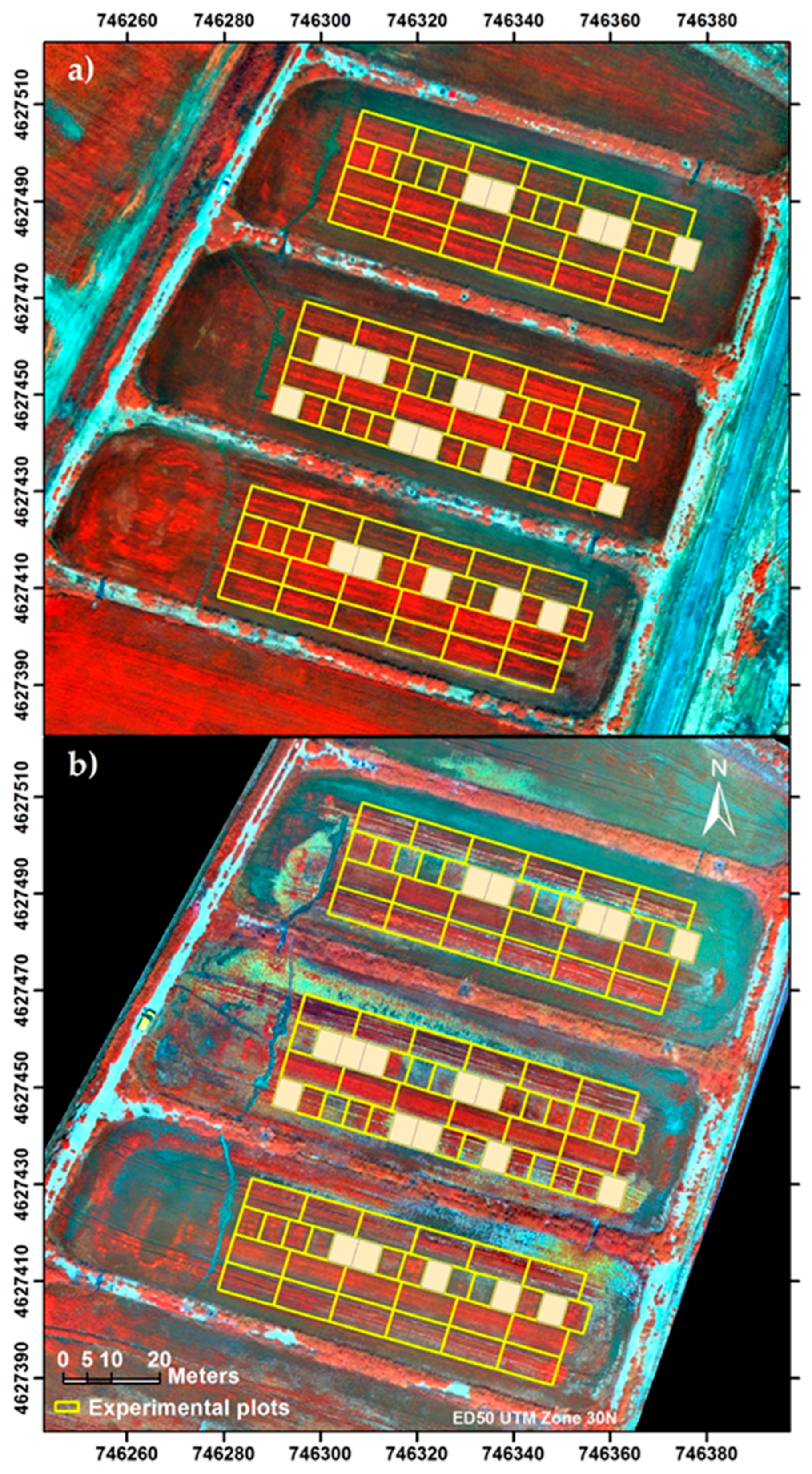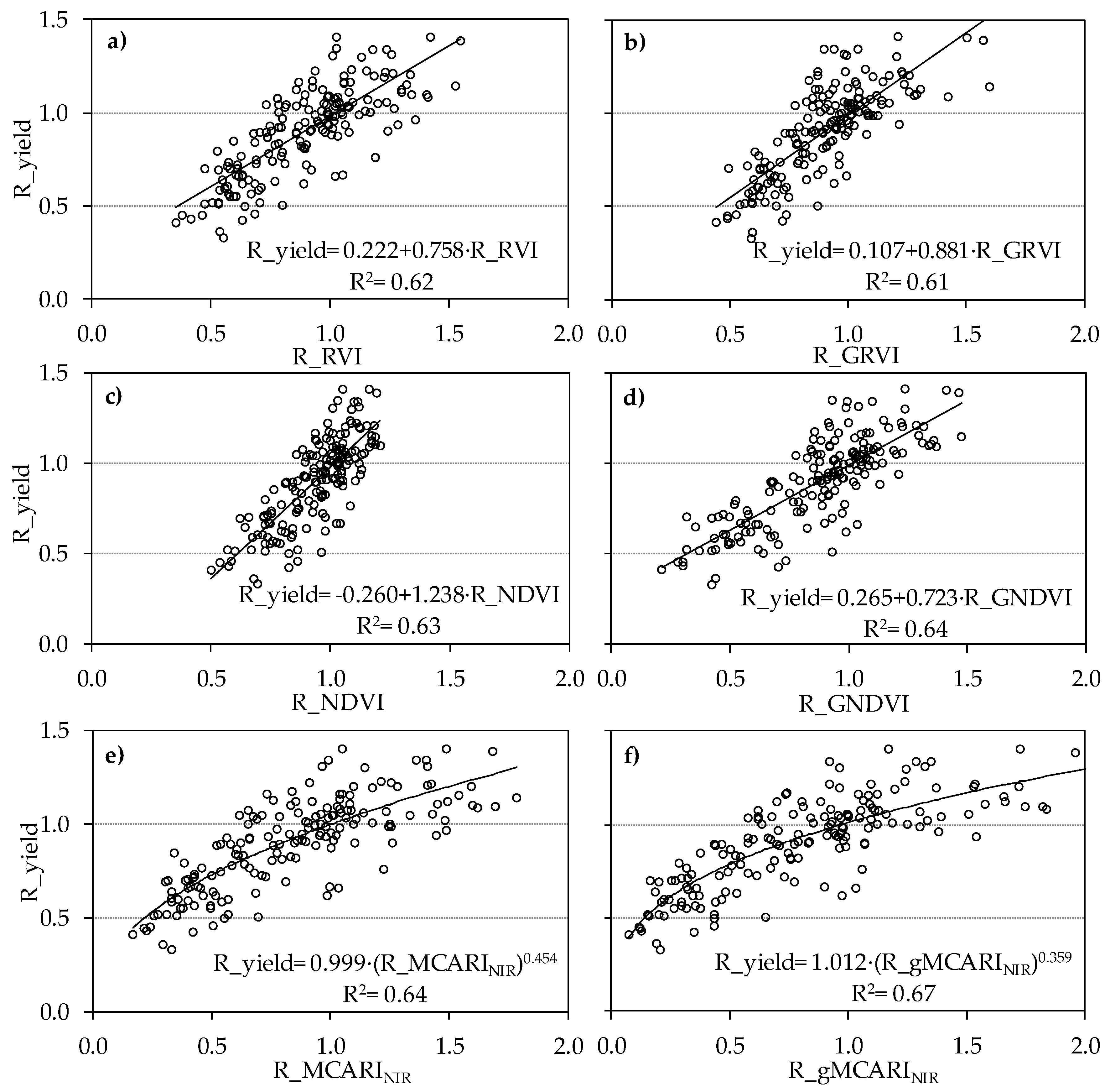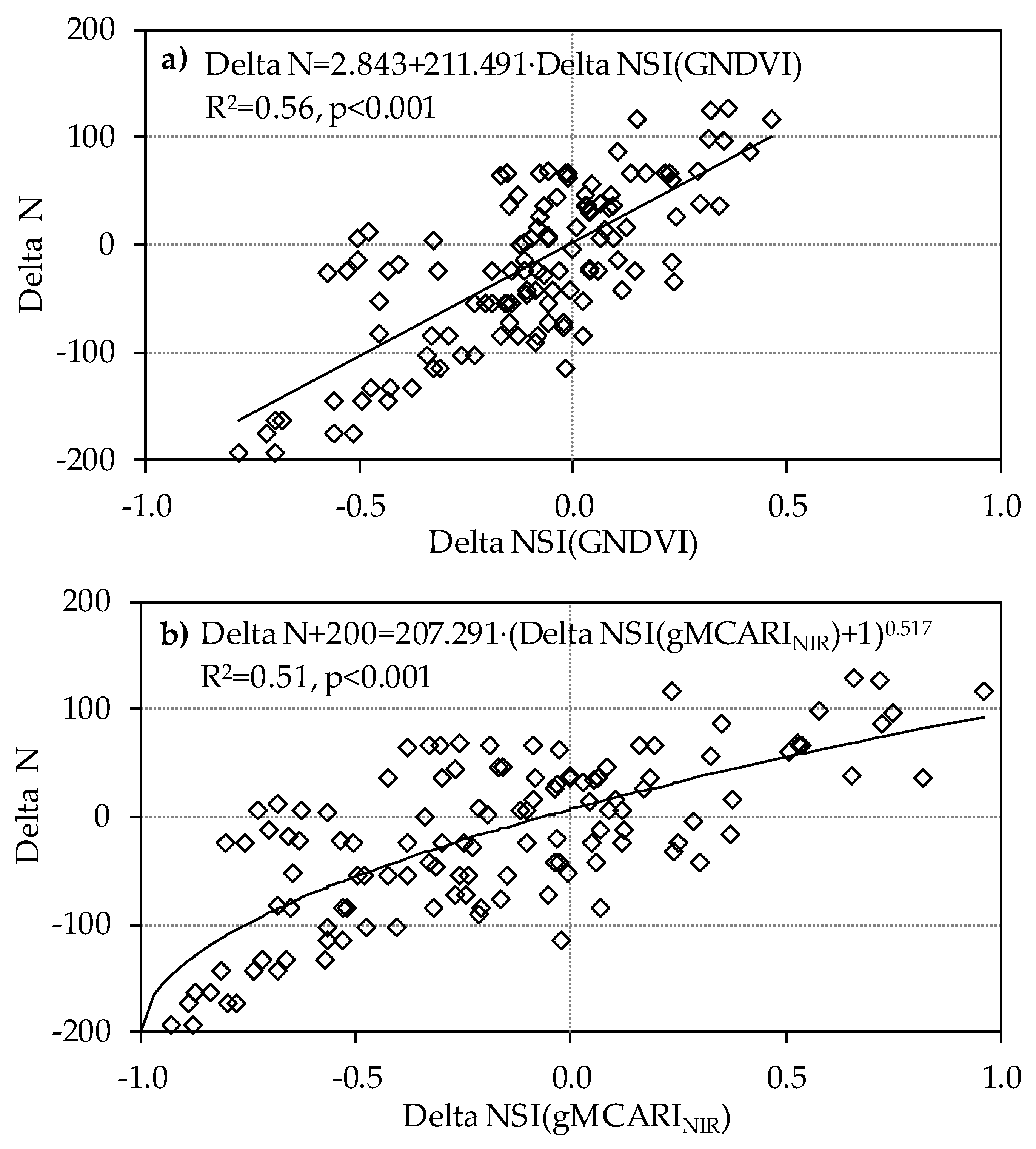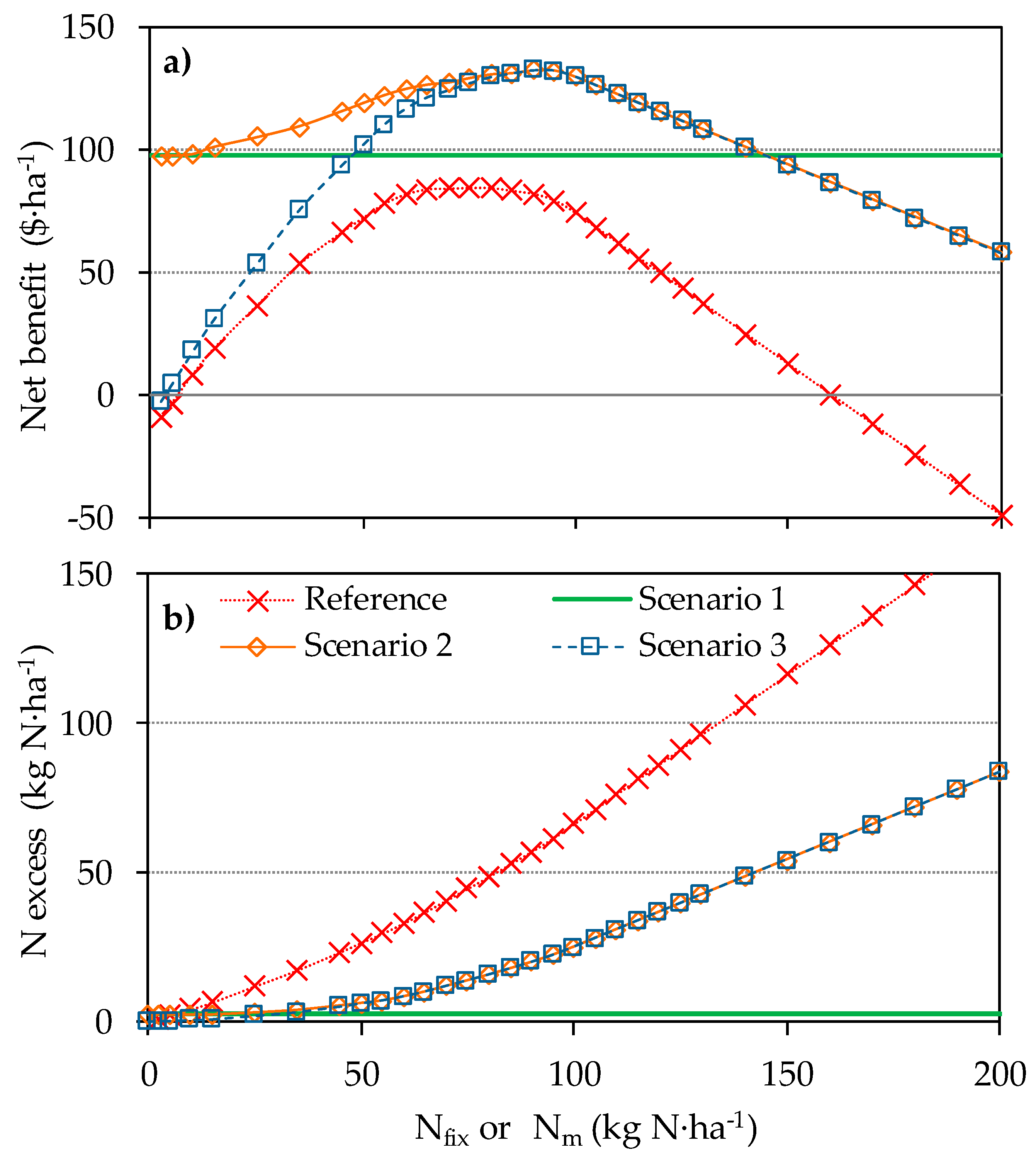Agronomic and Economic Potential of Vegetation Indices for Rice N Recommendations under Organic and Mineral Fertilization in Mediterranean Regions
Abstract
1. Introduction
- To establish and compare the relationships between different VIs derived from aerial multispectral information and yield at the rice booting stage, and evaluate possible differences in these relationships due to organic and mineral fertilization.
- To design and evaluate the agronomic performance of a N topdressing recommendation approach based on the information obtained in sub-objective 1.
- To compare economically and environmentally different scenarios for N adjustment based on the recommendation approach defined in sub-objective 2.
2. Materials and Methods
2.1. Experimental Design and Agricultural Practices
2.2. Spectral Information
2.3. Relationship between Yield and Vegetation Indices
2.4. N Topdressing Recommendation Approach
2.4.1. Design
2.4.2. Validation Process
- Success: Delta N was negative (i.e., the plot would have needed additional N fertilization) and the actual R_yield was below 1; or Delta N was positive (i.e., the plot would not have needed additional N fertilization) and the actual R_yield was equal or higher than 1.
- Failure by excess: Delta N was negative, but the actual R_yield was equal or above 1 (the approach would have recommended additional N fertilization, but the plot had reached the optimum yield).
- Failure by defect: Delta N was positive, but the actual R_yield was below 1, (the approach would not have recommended additional N fertilization, but the plot had not reached the optimum yield).
- The use of GNDVI
- The use of gMCARINIR
- The combination GNDVI & gMCARINIR: The plot will only be fertilized if both VIs recommend additional N fertilization.
- The combination GNDVI or gMCARINIR: If one of the VIs recommends N fertilization, the plot will be fertilized even if the other index does not recommend N fertilization.
2.4.3. Economic and Environmental Analysis
- Reference: All plots are fertilized with a fixed predefined N rate (Nfix) without using any recommendation approach. This practice is currently used by farmers in the study area and will be considered as the reference scenario.
- Scenario 1: Plots are fertilized according to Delta N estimates. Topdressing N is applied to the plots when Delta N is negative. The N rate is given by Delta N, (i.e., if Delta N = −30, N rate will be 30 kg N·ha−1) (Equation (9)).
- Scenario 2: Is a variation of scenario 1, but a minimum topdressing N rate (Nm) is established (Equation (10)). This option was considered since machinery is not prepared to apply fertilizers at low rates and farmers do not usually go inside the field to apply small N rates.
- Scenario 3: Is a variation of scenario 2. Plots are fertilized according to Delta N approach establishing a fixed predefined N rate (Nfix), i.e., if Delta N estimate is positive, the plots will not be fertilized, if the Delta N estimate is negative, the plots will be fertilized with Nfix (Equation (11)).
3. Results
3.1. Relationships between Yield and Vegetation Indices
3.1.1. Influence of the Year and TYPE of fertilizer
3.1.2. Performance and Comparison of the Indices
3.2. N Topdressing Recommendation Approach
3.2.1. Design of the N Topdressing Recommendation Approach
3.2.2. Assessment of the N Topdressing Recommendation Approach
4. Discussion
4.1. Relationships between Yield and Vegetation Indices
4.1.1. Influence of the Type of Fertilizer
4.1.2. Performance and Comparison of the Indices
4.2. Assessment of the N Topdressing Recommendation Approach
5. Conclusions
Author Contributions
Funding
Acknowledgments
Conflicts of Interest
References
- Mohanty, S. Trends in global rice consumption. Rice Today 2013, 12, 44–45. [Google Scholar]
- Cassman, K.G.; Peng, S.; Olk, D.C.; Ladha, J.K.; Reichardt, W.; Dobermann, A.; Singh, U. Opportunities for increased nitrogen-use efficiency from improved resource management in irrigated rice systems. Field Crop. Res. 1998, 56, 7–39. [Google Scholar] [CrossRef]
- FAOSTAT. Crops Production. Available online: http://faostat3.fao.org/home/E (accessed on 26 March 2015).
- MAPAMA. Superficies y Producciones de Cereales. Año 2016. Ministerio de Agricultura y Pesca, Alimentación y Medio Ambiente. Available online: http://www.magrama.gob.es/es/estadistica/temas/estadisticas-agrarias/agricultura/superficies-producciones-anuales-cultivos/ (accessed on 27 January 2018).
- MAPAMA. Encuestas ganaderas 2016. Ganado Porcino. Ministerio de Agricultura y Pesca, Alimentación y Medio Ambiente. Available online: http://www.magrama.gob.es/es/estadistica/temas/estadisticas-agrarias/ganaderia/encuestas-ganaderas/#para4 (accessed on 27 January 2018).
- Bond, J.A.; Bollich, P.K. Yield and quality response to rice cultivars to preflood and late-season nitrogen. Crop Manag. 2007. Available online: www.plantmanagementnetwork.org/cm/ (accessed on 5 July 2016). [CrossRef]
- Moreno-García, B.; Guillén, M.; Quílez, D. Response of paddy rice to fertilisation with pig slurry in northeast Spain: Strategies to optimise nitrogen use efficiency. Field Crop. Res. 2017, 208, 44–54. [Google Scholar] [CrossRef]
- Wilson, C.; Slaton, N.; Norman, R.; Miller, D. Efficient use of fertilizer. In Rice Production Handbook; University of Arkansas Division of Agriculture Cooperative Extension Service: Little Rock, AR, USA, 2001; pp. 51–75. [Google Scholar]
- Schlegel, A.J.; Grant, C.A.; Havlin, J.L. Challenging approaches to nitrogen fertilizer recommendations in continuous cropping systems in the Great Plains. Agron. J. 2005, 97, 391–398. [Google Scholar] [CrossRef]
- Nishikawa, T.; Li, K.Z.; Inoue, H.; Umeda, M.; Hirooka, H.; Inamura, T. Effects of the Long-Term Application of Anaerobically-Digested Cattle Manure on Growth, Yield and Nitrogen Uptake of Paddy Rice (Oryza sativa L.), and Soil Fertility in Warmer Region of Japan. Plant. Prod. Sci. 2012, 15, 284–292. [Google Scholar] [CrossRef]
- Xie, W.X.; Wang, G.H.; Zhang, Q.C.; Guo, H.C. Effects of nitrogen fertilization strategies on nitrogen use efficiency in physiology, recovery, and agronomy and redistribution of dry matter accumulation and nitrogen accumulation in two typical rice cultivars in Zhejiang, China. J. Zhejiang Univ. Sci. B 2007, 8, 208–216. [Google Scholar] [CrossRef] [PubMed]
- Denuit, J.P.; Olivier, M.; Goffaux, M.J.; Herman, J.L.; Goffart, J.P.; Destain, J.P.; Frankinet, M. Management of nitrogen fertilization of winter wheat and potato crops using the chlorophyll meter for crop nitrogen status assessment. Agronomie 2002, 22, 847–853. [Google Scholar] [CrossRef]
- Isla, R.; Valentín, F.; Quílez, D.; Guillén, M.; Aibar, J.; Maturano, M. Comparison of decision tools to improve the nitrogen management in irrigated maize under mediterranean conditions in Spain. In Proceedings of the 16th ASA Conference, Armidale, Australia, 14–18 October 2012. [Google Scholar]
- Peng, S.; Garcia, F.V.; Laza, R.C.; Sanico, A.L.; Visperas, R.M.; Cassman, K.G. Increased N-use efficiency using a chlorophyll meter on high-yielding irrigated rice. Field Crop. Res. 1996, 47, 243–252. [Google Scholar] [CrossRef]
- Yao, Y.; Miao, Y.; Huang, S.; Gao, L.; Ma, X.; Zhao, G.; Jiang, R.; Chen, X.; Zhang, F.; Yu, K.; Gnyp, M.L.; Bareth, G.; Liu, C.; Zhao, L.; Yang, W.; Zhu, H. Active canopy sensor-based precision N management strategy for rice. Agron. Sustain. Dev. 2012, 32, 925–933. [Google Scholar] [CrossRef]
- Cao, Q.; Miao, Y.; Shen, J.; Yu, W.; Yuan, F.; Cheng, S.; Huang, S.; Wang, H.; Yang, W.; Liu, F. Improving in-season estimation of rice yield potential and responsiveness to topdressing nitrogen application with Crop Circle active crop canopy sensor. Precis. Agric. 2015. [Google Scholar] [CrossRef]
- Huang, S.; Miao, Y.; Zhao, G.; Yuan, F.; Ma, X.; Tan, C.; Yu, W.; Gnyp, M.L.; Lenz-Wiedemann, V.I.S.; Rascher, U.; Bareth, G. Satellite remote sensing-based in-season diagnosis of rice nitrogen status in Northeast China. Remote Sens. 2015, 7, 10646–10667. [Google Scholar] [CrossRef]
- Matese, A.; Toscano, P.; Di Gennaro, S.F.; Genesio, L.; Vaccari, F.P.; Primicerio, J.; Belli, C.; Zaldei, A.; Bianconi, R.; Gioli, B. Intercomparison of UAV, aircraft and satellite remote sensing platforms for precision viticulture. Remote Sens. 2015, 7, 2971–2990. [Google Scholar] [CrossRef]
- Chen, Q.; Tian, Y.; Yao, X.; Cao, W.; Zhu, Y. Comparison of five nitrogen dressing methods to optimize rice growth. Plant. Prod. Sci. 2014, 17, 66–80. [Google Scholar] [CrossRef]
- Xue, L.; Yang, L. Recommendations for nitrogen fertiliser topdressing rates in rice using canopy reflectance spectra. Biosyst. Eng. 2008, 100, 524–534. [Google Scholar] [CrossRef]
- Xue, L.; Li, G.; Qin, X.; Yang, L.; Zhang, H. Topdressing nitrogen recommendation for early rice with an active sensor in south China. Precis. Agric. 2014, 15, 95–110. [Google Scholar] [CrossRef]
- Casanova, D.; Epema, G.F.; Goudriaan, J. Monitoring rice reflectance at field level for estimating biomass and LAI. Field Crop. Res. 1998, 55, 83–92. [Google Scholar] [CrossRef]
- Gnyp, M.L.; Miao, Y.; Yuan, F.; Ustin, S.L.; Yu, K.; Yao, Y.; Huang, S.; Bareth, G. Hyperspectral canopy sensing of paddy rice aboveground biomass at different growth stages. Field Crop. Res. 2014, 155, 42–55. [Google Scholar] [CrossRef]
- Gilabert, M.A.; Meliá, J. Usefulness of the temporal analysis and the normalized difference in the study of rice by means of landsat-5 TM images: Establishment of Relationships for Yield Prediction Purpose. Geocarto Int. 1990, 5, 27–32. [Google Scholar] [CrossRef]
- Li, W.; Niu, Z.; Wang, C.; Huang, W.; Chen, H.; Gao, S.; Li, D.; Muhammad, S. Combined Use of Airborne LiDAR and Satellite GF-1 Data to Estimate Leaf Area Index, Height, and Aboveground Biomass of Maize during Peak Growing Season. IEEE J. Sel. Top. Appl. Earth Obs. Remote Sens. 2015, 8, 4489–4501. [Google Scholar] [CrossRef]
- Sultana, S.R.; Ali, A.; Ahmad, A.; Mubeen, M.; Zia-Ul-Haq, M.; Ahmad, S.; Ercisli, S.; Jaafar, H.Z.E. Normalized difference vegetation index as a tool for wheat yield estimation: A case study from Faisalabad, Pakistan. Sci. World J. 2014, 2014. [Google Scholar] [CrossRef] [PubMed]
- Quarmby, N.A.; Milnes, M.; Hindle, T.L.; Silleos, N. The use of multi-temporal NDVI measurements from AVHRR data for crop yield estimation and prediction. Int. J. Remote Sens. 1993, 14, 199–210. [Google Scholar] [CrossRef]
- Raun, W.R.; Solie, J.B.; Johnson, G.V.; Stone, M.L.; Mutten, R.W.; Freeman, K.W.; Thomason, W.E.; Lukina, E.V. Improving nitrogen use efficiency in cereal grain production with optical sensing and variable rate application. Agron. J. 2002, 94, 815–820. [Google Scholar] [CrossRef]
- Harrell, D.L.; Tubana, B.S.; Walker, T.W.; Phillips, S.B. Estimating Rice Grain Yield Potential Using Normalized Difference Vegetation Index. Agron. J. 2011, 103, 1717–1723. [Google Scholar] [CrossRef]
- Gitelson, A.A.; Kaufman, Y.J.; Merzlyak, M.N. Use of a green channel in remote sensing of global vegetation from EOS-MODIS. Remote Sens. Environ. 1996, 58, 289–298. [Google Scholar] [CrossRef]
- Haboudane, D.; Miller, J.R.; Pattey, E.; Zarco-Tejada, P.J.; Strachan, I.B. Hyperspectral vegetation indices and novel algorithms for predicting green LAI of crop canopies: Modeling and validation in the context of precision agriculture. Remote Sens. Environ. 2004, 90, 337–352. [Google Scholar] [CrossRef]
- Daughtry, C.S.T.; Walthall, C.L.; Kim, M.S.; De Colstoun, E.B.; McMurtrey, J.E., III. Estimating corn leaf chlorophyll concentration from leaf and canopy reflectance. Remote Sens. Environ. 2000, 74, 229–239. [Google Scholar] [CrossRef]
- Cao, Q.; Miao, Y.; Wang, H.; Huang, S.; Cheng, S.; Khosla, R.; Jiang, R. Non-destructive estimation of rice plant nitrogen status with Crop Circle multispectral active canopy sensor. Field Crop. Res. 2013, 154, 133–144. [Google Scholar] [CrossRef]
- Busetto, L.; Casteleyn, S.; Granell, C.; Pepe, M.; Barbieri, M.; Campos-Taberner, M.; Casa, R.; Collivignarelli, F.; Confalonieri, R.; Crema, A. Downstream services for rice crop monitoring in Europe: From regional to local scale. IEEE J. Sel. Top. Appl. Earth Obs. Remote Sens. 2017, 10, 5423–5441. [Google Scholar] [CrossRef]
- Nutini, F.; Confalonieri, R.; Crema, A.; Movedi, E.; Paleari, L.; Stavrakoudis, D.; Boschetti, M. An operational workflow to assess rice nutritional status based on satellite imagery and smartphone apps. Comput. Electron. Agric. 2018, 154, 80–92. [Google Scholar] [CrossRef]
- Confalonieri, R.; Foi, M.; Casa, R.; Aquaro, S.; Tona, E.; Peterle, M.; Boldini, A.; De Carli, G.; Ferrari, A.; Finotto, G.; Guarneri, T.; Manzoni, V.; Movedi, E.; Nisoli, A.; Paleari, L.; Radici, I.; Suardi, M.; Veronesi, D.; Bregaglio, S.; Cappelli, G.; Chiodini, M.E.; Dominoni, P.; Francone, C.; Frasso, N.; Stella, T.; Acutis, M. Development of an app for estimating leaf area index using a smartphone. Trueness and precision determination and comparison with other indirect methods. Comput. Electron. Agric. 2013, 96, 67–74. [Google Scholar] [CrossRef]
- Confalonieri, R.; Paleari, L.; Movedi, E.; Pagani, V.; Orlando, F.; Foi, M.; Barbieri, M.; Pesenti, M.; Cairati, O.; La Sala, M.S.; Besana, R.; Minoli, S.; Bellocchio, E.; Croci, S.; Mocchi, S.; Lampugnani, F.; Lubatti, A.; Quarteroni, A.; De Min, D.; Signorelli, A.; Ferri, A.; Ruggeri, G.; Locatelli, S.; Bertoglio, M.; Dominoni, P.; Bocchi, S.; Sacchi, G.A.; Acutis, M. Improving invivo plant nitrogen content estimates from digital images: Trueness and precision of a new approach as compared to other methods and commercial devices. Biosyst. Eng. 2015, 135, 21–30. [Google Scholar] [CrossRef]
- Piccinini, S.; Bortone, G. The fertilizer value of agricultural manure: Simple rapid methods of assessment. J. Agric. Eng. Res. 1991, 49, 197–208. [Google Scholar] [CrossRef]
- Yagüe, M.R.; Quílez, D. On-farm Measurement of Electrical Conductivity for the Estimation of Ammonium Nitrogen Concentration in Pig Slurry. J. Environ. Qual. 2012, 41, 893–900. [Google Scholar] [CrossRef] [PubMed]
- Jordan, C.F. Derivation of Leaf-Area Index from Quality of Light on the Forest Floor. Ecology 1969, 50, 663–666. [Google Scholar] [CrossRef]
- Inada, K. Spectral ratio of reflectance for estimating chlorophyll content of leaf. Jpn. J. Crop Sci. 1985, 54, 261–265. [Google Scholar] [CrossRef]
- Rouse, J.W.J.; Hass, R.H.; Schell, J.A.; Deering, D.W. Monitoring vegetation systems in the great plains with ERTS. In Proceedings of the Third Earth Resources Technology Satellite-1 Symposium, Washington, DC, USA, 10–14 December 1973; pp. 309–317. [Google Scholar]
- Tucker, C.J.; Elgin, J.H.; McMurtrey, J.E.; Fan, C.J. Monitoring corn and soybean crop development with hand-held radiometer spectral data. Remote Sens. Environ. 1979, 8, 237–248. [Google Scholar] [CrossRef]
- Wang, Y.P.; Chang, K.W.; Chen, R.K.; Lo, J.C.; Shen, Y. Large-area rice yield forecasting using satellite imageries. Int. J. Appl. Earth Obs. Geoinf. 2010, 12, 27–35. [Google Scholar] [CrossRef]
- Cerrato, M.E.; Blackmer, A.M. Comparison of models for describing corn yield response to nitrogen-fertilizer. Agron. J. 1990, 82, 138–143. [Google Scholar] [CrossRef]
- Dixon, W.J. BMDP Statistical Software Manual; University of California Press: Berkeley, CA, USA, 1985. [Google Scholar]
- IAEST. Precios Pagados por los Agricultores. Coyuntura Agraria de Aragón. Departamento de Desarrollo Rural y Sostenibilidad. Available online: http://www.aragon.es/DepartamentosOrganismosPublicos/Institutos/InstitutoAragonesEstadistica/AreasTematicas/10_Precios/ci.08_Precios_agrarios.detalleDepartamento (accessed on 8 March 2016).
- Zhao, J.; Dong, S.T.; Liu, P.; Zhang, J.W.; Zhao, B. Effects of long-term mixed application of organic and inorganic fertilizers on canopy apparent photosynthesis and yield of winter wheat. Chin. J. Appl. Ecol. 2015, 26, 2362–2370. [Google Scholar]
- Shahid, M.; Shukla, A.K.; Bhattacharyya, P.; Tripathi, R.; Mohanty, S.; Kumar, A.; Lal, B.; Gautam, P.; Raja, R.; Panda, B.B.; Das, B.; Nayak, A.K. Micronutrients (Fe, Mn, Zn and Cu) balance under long-term application of fertilizer and manure in a tropical rice-rice system. J. Soils Sed. 2016, 16, 737–747. [Google Scholar] [CrossRef]
- Dong, W.; Zhang, X.; Wang, H.; Dai, X.; Sun, X.; Qiu, W.; Yang, F. Effect of Different Fertilizer Application on the Soil Fertility of Paddy Soils in Red Soil Region of Southern China. PLoS ONE 2012, 7. [Google Scholar] [CrossRef] [PubMed]
- Huang, Q.R.; Hu, F.; Huang, S.; Li, H.X.; Yuan, Y.H.; Pan, G.X.; Zhang, W.J. Effect of Long-Term Fertilization on Organic Carbon and Nitrogen in a Subtropical Paddy Soil. Pedosphere 2009, 19, 727–734. [Google Scholar] [CrossRef]
- Chang, K.W.; Shen, Y.; Lo, J.C. Predicting rice yield using canopy reflectance measured at booting stage. Agron. J. 2005, 97, 872–878. [Google Scholar] [CrossRef]





| Pig Slurry Treatments (PS) | Mineral Treatments (M) | ||||
|---|---|---|---|---|---|
| BS | TP | BS | TP | ||
| kg NH4-N·ha−1 | kg N·ha−1 | kg N·ha−1 | |||
| PS120M0 | 120 | - | M120M0 | 120 | - |
| PS120M30 | 120 | 30 | M120M30 | 120 | 30 |
| PS120M60 | 120 | 60 | M120M60 | 120 | 60 |
| PS120M90 | 120 | 90 | M120M90 | 120 | 90 |
| PS120M120 | 120 | 120 | M120M120 | 120 | 120 |
| PS120M150 | 120 | 150 | |||
| PS170M0 | 170 | - | Control (M0) | - | - |
| PS170M30 | 170 | 30 | M30 | 30 | - |
| PS170M60 | 170 | 60 | M60 | 60 | - |
| PS170M90 | 170 | 90 | M90 | 90 | - |
| PS170M120 | 170 | 120 | M120 = M120M0 | 120 | - |
| PS170M150 | 170 | 150 | M150 | 150 | - |
| Indices (VIs) | Formula | Reference |
|---|---|---|
| RVI Ratio Vegetation Index | NIR/R | [40] |
| GRVI Green Ratio Vegetation Index | NIR/G | [41] |
| NDVI Normalized Difference Vegetation Index | (NIR-R)/(NIR+R) | [42] |
| GNDVI Green Normalized Difference Vegetation Index | (NIR-G)/(NIR+G) | [30] |
| MCARI1 Modified Chlorophyll Absorption in Reflectance Index1 | 1.2[2.5(NIR-R)-1.3(NIR-G)] | [31] |
| MCARINIR Modified Chlorophyll Absorption in Reflectance IndexNIR | [(NIR-R)-0.2(NIR-G)](NIR/R) | Adapted from Cao et al. [33] |
| gMCARINIR Green peak Modified Chlorophyll Absorption in Reflectance IndexNIR | [(NIR-R)-(G-R)](NIR/R) = (NIR-G)(NIR/R) | Proposed in this study |
| R_RVI | R_GRVI | R_NDVI | R_GNDVI | R_MCARI1 | R_MCARINIR | R_gMCARINIR | |
|---|---|---|---|---|---|---|---|
| 2012 | y = 0.22 + 0.74x | y = 0.04 + 0.93x | y = −0.18 + 1.13x | y = 0.29 + 0.68x | y = −0.22 + 1.18x | y = 0.98x0.43 | y = 1.00x0.33 |
| 2013 | y = 0.22 + 0.75x | y = 0.14 + 0.84x | y = −0.39 + 1.36x | y = 0.22 + 0.76x | y = −0.17 + 1.12x | y = 0.99x0.48 | y = 1.01x0.39 |
| PS | y = 0.25 + 0.75x | y = 0.20 + 0.80x | y = −0.26 + 1.26x | y = 0.31 + 0.70x | y = −0.12 + 1.12x | y = 1.03x0.44 | y = 1.04x0.35 |
| M | y = 0.19 + 0.72x | y = −0.01 + 0.94x | y = −0.26 + 1.17x | y = 0.22 + 0.71x | y = −0.33 + 1.21x | y = 0.93x0.46 | y = 0.95x0.37 |
| Year | n.s. | n.s. | n.s. | n.s. | n.s. | n.s. | n.s |
| Fertilizer | *** | *** | *** | ** | *** | *** | *** |
| Model Type † | 2012 n = 88 | 2013 n = 83 | Pooled 2012+2013 n = 171 | ||
|---|---|---|---|---|---|
| R2 | R2 | R2 | RMSE | ||
| R_RVI | L | 0.70 *** | 0.56 *** | 0.62 *** | 0.149 |
| R_GRVI | L | 0.74 *** | 0.53 *** | 0.61 *** | 0.151 |
| R_NDVI | L | 0.74 *** | 0.56 *** | 0.63 *** | 0.148 |
| R_GNDVI | L | 0.77 *** | 0.56 *** | 0.64 *** | 0.144 |
| R_MCARI1 | L | 0.69 *** | 0.40 *** | 0.52 *** | 0.168 |
| R_MCARINIR | M | 0.74 *** | 0.58 *** | 0.64 *** | 0.145 |
| R_gMCARINIR | M | 0.77 *** | 0.61 *** | 0.67 *** | 0.139 |
| Strategy | SUCCESS | EXCESS | DEFECT |
|---|---|---|---|
| R_GNDVI | 83.3 | 12.5 | 4.2 |
| R_gMCARINIR | 87.5 | 4.2 | 8.3 |
| R_GNDVI&R_gMCARINIR | 87.5 | 4.2 | 8.3 |
| R_GNDVI or R_gMCARINIR | 83.3 | 12.5 | 4.2 |
© 2018 by the authors. Licensee MDPI, Basel, Switzerland. This article is an open access article distributed under the terms and conditions of the Creative Commons Attribution (CC BY) license (http://creativecommons.org/licenses/by/4.0/).
Share and Cite
Moreno-García, B.; Casterad, M.A.; Guillén, M.; Quílez, D. Agronomic and Economic Potential of Vegetation Indices for Rice N Recommendations under Organic and Mineral Fertilization in Mediterranean Regions. Remote Sens. 2018, 10, 1908. https://doi.org/10.3390/rs10121908
Moreno-García B, Casterad MA, Guillén M, Quílez D. Agronomic and Economic Potential of Vegetation Indices for Rice N Recommendations under Organic and Mineral Fertilization in Mediterranean Regions. Remote Sensing. 2018; 10(12):1908. https://doi.org/10.3390/rs10121908
Chicago/Turabian StyleMoreno-García, Beatriz, Mª Auxiliadora Casterad, Mónica Guillén, and Dolores Quílez. 2018. "Agronomic and Economic Potential of Vegetation Indices for Rice N Recommendations under Organic and Mineral Fertilization in Mediterranean Regions" Remote Sensing 10, no. 12: 1908. https://doi.org/10.3390/rs10121908
APA StyleMoreno-García, B., Casterad, M. A., Guillén, M., & Quílez, D. (2018). Agronomic and Economic Potential of Vegetation Indices for Rice N Recommendations under Organic and Mineral Fertilization in Mediterranean Regions. Remote Sensing, 10(12), 1908. https://doi.org/10.3390/rs10121908






